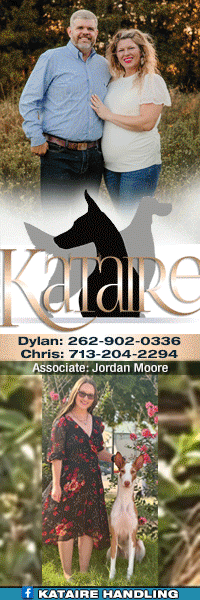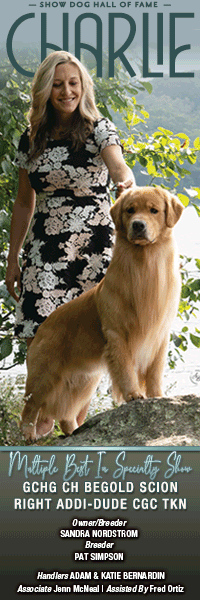Jane Forsyth – A Legacy That Will Never Be Forgotten
From the archives of The Canine Chronicle, November/December 2015
Click here to read the complete article
by Amy Fernandez
 The Boxer heyday of the 1950s was definitely winding down by 1970 when Ch. Arriba’s Prima Donna added the final jewel to its crown of Westminster triumphs.
The Boxer heyday of the 1950s was definitely winding down by 1970 when Ch. Arriba’s Prima Donna added the final jewel to its crown of Westminster triumphs.
For years the breed seemed unstoppable, but it had been two decades since its last Westminster triumph. It didn’t seem like a likely prospect that year considering the top guns in that BIS lineup: Frank Sabella, Corky Vroom, Pat Craige, and Ric Chashoudian. Even so, the intimidation factor was non-existent for Jane Forsyth who then ranked as America’s top handler having shown 29 top ten dogs amongst all breeds during the 11 years the Phillips System had been tracking that stuff.
Born March 3, 1929 in Cambridge, Massachussets, Jane Kamp’s education in the sport started at birth. Her mother, Katherine, bred and showed Airedales, later founding her Boxer breeding program with an imported Utz daughter. That was Janie’s introduction to the Von Dom bloodline that was destined to revolutionize Boxer type.
At nine, Janie handled one of her mom’s Airedales to a CD, the first of countless AKC titles that would define her career. Although she came from a background in this sport, it was obvious from the start that Janie’s enthusiasm and dedication was off the charts. Even then, she demonstrated an exceptional ability to focus on the big picture and apply her talents, first and foremost an exceptionally good eye for dogs.
That was the general consensus. By her teens, she was managing and handling Elblac Dobermans, Grafmar German Shepherds, and Renfrew and Dorick Boxers. That led to her professional start in partnership with George Pusey in Holliston, Massachusetts. Their Grayarlin kennel earned ABC’s top breeder award for three years.
Boxers had knocked around America for decades prior to their meteoric ascendancy in the 1950s. The first wave of big winners stemmed from pre-war imports from Frau Stockmann’s Von Dom kennel. A few dogs made their mark before World War II, but John and Maize Wagner made the Boxer a BIS frontrunner. Their Mazelaine kennel produced Ch. Warlord of Mazelaine who won the Westminster group in 1945 and ‘46, then reaching the pinnacle with BIS in 1947. Warlord’s sister produced Ch. Mazelaine’s Zazarac Brandy, the 1949 Westminster winner. That year also heralded the debut of Bang Away of Sirrah Crest, the Boxer that truly became the first canine superstar in American popular culture. He retired with 121 BIS wins and stamped his progeny with his hallmark qualities of good feet, elegant neck and shoulders, short-coupled profile, and superlative showmanship.
During Bang Away’s final year as top dog all breeds in 1955, his daughter, Ch. Baroque of Quality Hill, rose through the ranks to second place. At the time, Janie was handling her brother, Barrage, for Mr. and Mrs. Jouett Shouse, a dog that many considered the finest of Bang Away’s 80+ champion offspring.
Both directly and indirectly, Bang Away ensured that Boxer supremacy remained unchallenged for many years. From 1951-52 Boxer registrations increased by an astounding 26 percent with almost 35,000 registrations during that period. They ranked as the third most popular breed, accounting for 11 percent of total AKC registrations. Everyone and his brother wanted to show a Boxer. From that perspective, it was money in the bank for professional handlers. On the other hand, competition was a war zone. Boxers were destined to dominate all breed and group ratings well into the 1960s. Plenty of handlers walked in the Boxer ring and picked up nice paychecks during that era. Only a few rose to the top.
Janie handled many Boxers to record setting careers but nothing illustrates her contribution to the breed better than the rise of Salgray in nearby Brookline, Massachussets. During those years Grayarlin provided foundation stock for some of the era’s most successful breeders including Daniel and Phyllis Hamilburg who purchased their first Grayarlin Boxer as a pet in 1952. They soon returned for a show dog, and with Janie’s mentoring and linebred stock, these novice breeders suffered no missteps as they turned out an endless string of recordbreaking winners becoming, among other things, America’s top Boxer kennel by 1955. That was far from her only Boxer project during those years.
Her major focus was managing the career of Ch Barrage of Quality Hill. Along with arranging the portentous breeding to Ch. Slipper of Grayarlin that ignited Salgray’s success, she handled him to Best American Bred in Show at Westminster in 1955 and a near miss for BIS there in 1957. He ended 1956 as the top Working dog and number four all breeds and ultimately sired 45 champions.

A year later she showed Ch. Ruda River’s Ebony Belle to a finish as a top ten Working dog of 1957. The following year she brought out a Barrage son, Ch. Salgray’s Battle Chief, getting him into the Working group top ten by the end of 1959. She then brought out another Bang Away son, Ch. Marquam Hills Comanche, who also ended 1960 as a top ten Working dog.
Boxers were a bankable asset at the moment. However, Bang Away was the third Boxer to pull off a Westminster Best within five years. Fanciers were awed, but they also have short memories. A few decades earlier, Airedales basically did the same thing, and by 1951 their picture wasn’t pretty. Coming from a background in Airedales, Janie understood this all too well. The gravy train could end at any time. Diversification was the key to professional security. She presented many top Boxers, but it was far from the only breed she took to the top. She had a client who made sure of that.
Today, well-heeled backers are an essential feature of the game. Quite possibly, Mrs. Cheever Porter was the first wealthy fancier to promote a wide range of top winners in many breeds.
In 1962 Janie brought out her Boxer, Ch. Flintwood’s Rabble Rouser, and kept him in the all breed top ten for three consecutive years. She also handled a number of Setters for her during those years. Some notables included the English Setter, Ch. Candlewood Distinction, which she handled to top ten Sporting dog 1962-64. She handled many of Mrs. Porter’s Irish Setters. Ch. Shawnlea Fanfare was a top ten sporting dog in 1960, Ch. Tyronne Farm Rex was a top ten Sporting dog in 1963, Ch. Cherry Point Brask was a top ten Sporting dog in 1964, and in 1966 she handled Am. Can. Ch. Webline Rio Hondo to eighth in all breed rankings.
She also campaigned Mrs. Porter’s famed Afghan, Ch. Holly Hill Desert Wind, to top Hound 1963-66 and seventh in all breed rankings in 1966. Windy epitomized the glamour and style that riveted public attention on the breed during that era. The New York Times played it the max as shown in this November 26, 1967 show report detailing Windy’s triumph at Capital Kennel Club over an entry of 1541 including the Maltese, Ch. Aennchen’s Poona Dancer, John LaFore’s recently imported Kees handled by Roy Holloway, and Walter Goodman’s Skye, Ch. Glamoor Go Go Go.
“It was the 32nd BIS for the five-year-old apricot dog owned by Mrs. Cheever Porter. Judge Forest Hall who had judged him several times was almost lyrical in his praise of the hound. He said, “The dog like good liquor seems to improve with the years. He is a great showman with tremendous soundness and excellent condition.” Ever practical, Janie made the most of this media opportunity. It was reported, “When the pictures had been taken, Mrs. Forsyth let go of the lead and Windy romped after a squeaky rubber toy for all the world like a youngster.” Those flashbulbs started popping again.
From the archives of The Canine Chronicle, November/December 2015
Click here to read the complete article

Short URL: http://caninechronicle.com/?p=92956
Comments are closed











